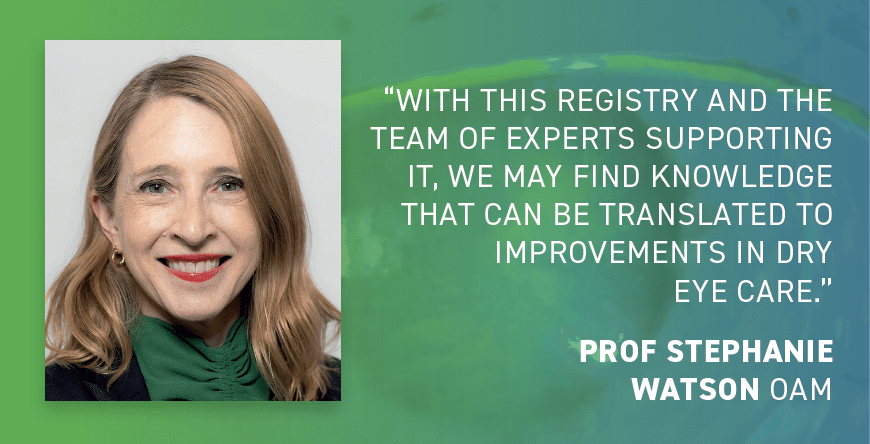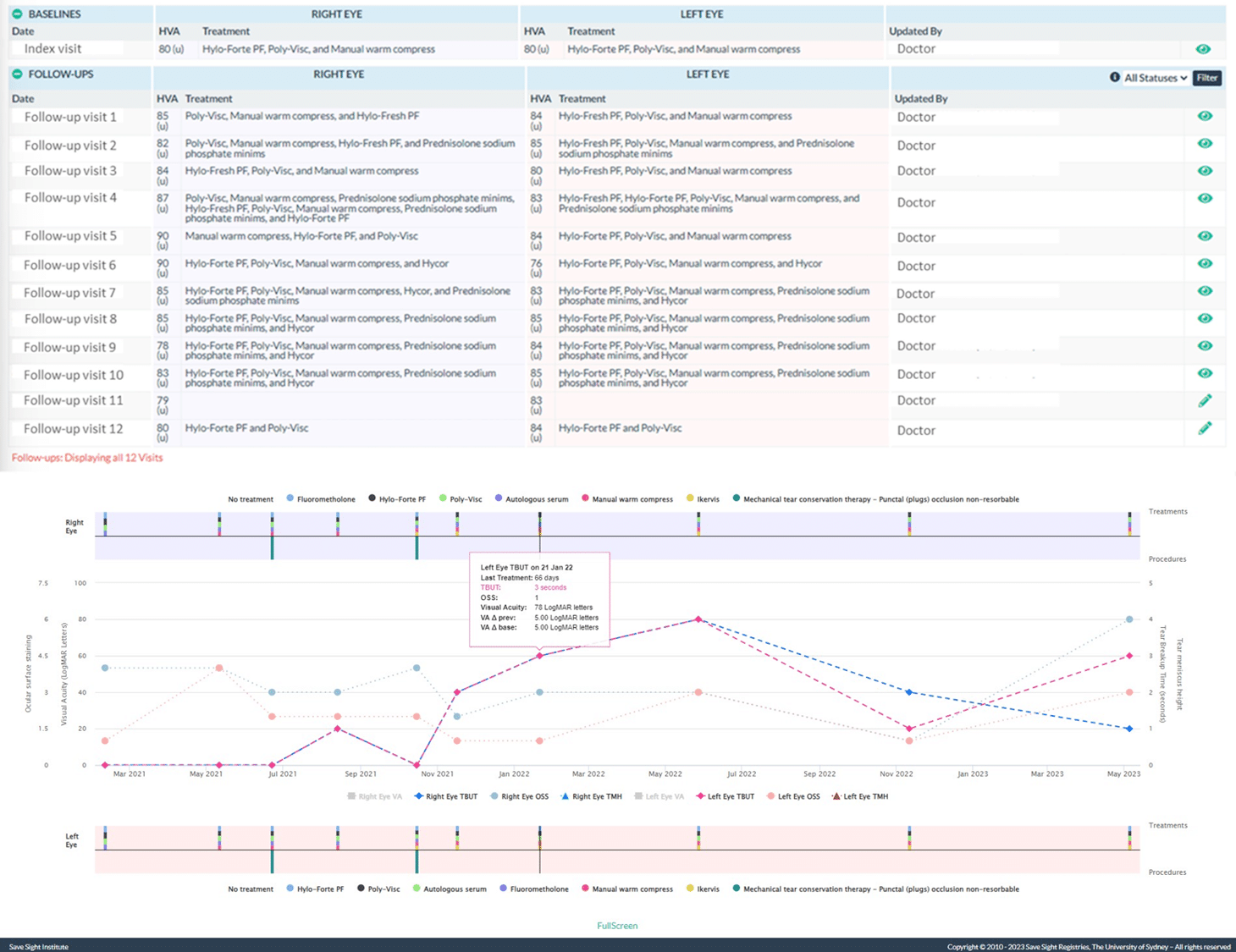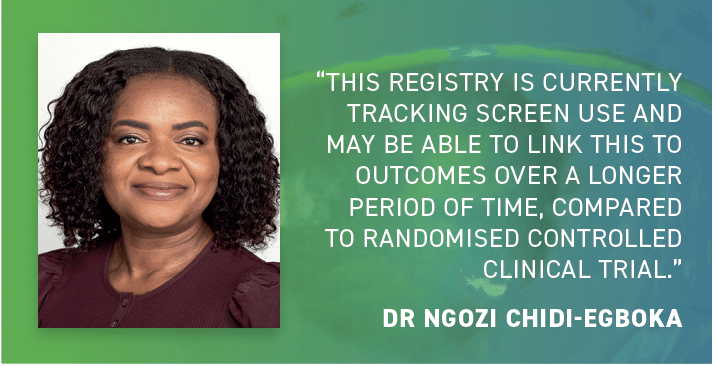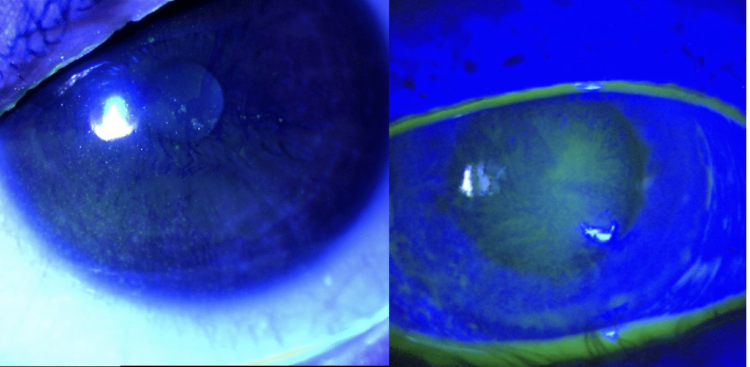A lack of understanding about treatment outcomes and natural history of dry eye in the real world – absent in data collected from clinical trials – led to the development of the Save Sight Institute Dry Eye Registry, which is tracking the clinical features and outcomes of dry eye disease in its growing cache of data.
The Save Sight Dry Eye Registry, launched in December 2020, is currently being used by 35 clinicians from 27 sites in seven countries – including Australia, Spain, United Kingdom, Germany and France – to monitor treatment effectiveness and patient outcomes.
Those figures are only scratching at the surface of the potential trove of intel this registry could provide for dry eye management going forward.
The web-based registry is free, accessible to optometrists and ophthalmologists – and anonymous, meaning data are encrypted and stored in a secure server. Only individual eyecare practitioners can see their own data. Practitioners can obtain CPD points from RANZCO and Optometry Australia for using the registry.
The registry provides an interactive visual summary of each patient’s treatment journey, and anonymised reports allow users to compare their patient outcomes with their peers.
Why was the Save Sight Dry Eye Registry established?
The Save Sight Dry Eye Registry was established by Professor Stephanie Watson OAM, head of the corneal research group at the Save Sight Institute, The University of Sydney and is based on the globally successful Fight Retinal Blindness! project led by Professor Mark Gillies.

As Watson explains, registries address an unmet need in ophthalmology for real-world evidence; that is to understand treatment outcomes in everyday practice. For dry eye, randomised controlled trials have been providing evidence on treatments with patients enrolled using strict inclusion and exclusion criteria and conducted over the short term. Watson says that with optometrists managing many dry eye patients there was also a need to collaboratively collect data from both ophthalmology and optometry practices.
“The Save Sight Dry Eye Registry is unique as it is the first collaborative registry, across ophthalmology and optometry to collect data from everyday clinical practice on dry eye treatment outcomes over the long-term. Patient-reported outcomes are also collected by the registry and will enable us to understand the impact of dry eye on quality-of-life and the benefit to patients of treatments in the real world. The ability to collect longitudinal data may also improve understanding of dry eye natural history,” Watson says.
“Watching the registry grow globally will enable us to compare dry eye treatment outcomes and natural history across countries; with data collected on patient demographics and general health, our understanding of why dry eye prevalence varies across the globe may improve.”
The Save Sight Dry Eye Registry has also brought together a team of international experts on the steering committee. With Watson as chair, the steering committee members include Dr Alberto Recchioni, Dr David Mingo, Dr Fanny Babeau, Scientia Professor Fiona Stapleton AO, Dr Francisco Arnalich-Montiel, Professor Gerd Geerling, Dr Himal Kandel, Professor Jennifer Craig, Associate Professor Laura Downie, Dr Ngozi Chidi-Egboka, Professor Saaeha Rauz, and Professor Vincent Daien.
“Working with experts in the field on the steering committee has made the registry project an enjoyable and valuable experience. There is a significant amount of research that needs to be done to relieve suffering in dry eye. It is rewarding to know that with this registry and the team of experts supporting it, we may find knowledge that can be translated to improvements in dry eye care,” Watson explains.

Save Sight Institute postdoctoral research associate Dr Ngozi Chidi-Egboka, who has been involved in the registry since March 2023, says the registry plugs a hole in dry eye research.
She says at least one in four Australians have dry eye disease, resulting in considerable costs to the Australian health sector, and the burden is growing globally.
“Given the increase in the use of digital devices and correlation with myopia control, dry eye is largely on the increase – not only in adults but kids as well. So, we need to understand the natural history, and treatment outcomes to know how to best manage the disease,” she says.
“Data from the registry will inform the clinicians managing patients with dry eye in everyday practice and researchers developing dry eye treatments. That was the reason why the Dry Eye Registry was set up, so that we can collect the day-to-day data from normal clinical practice.”
By encouraging optometrists and ophthalmologists to use the registry, to record the treatment journey of their patients, the Save Sight Institute is hoping the data from the Dry Eye Registry will be able to inform researchers of evidence-based outcomes from dry eye treatment.
“We collect data of all the medications the patient has ever used, not restricting them to only one medication, as we find in most clinical studies. We want to see the outcome of treatment as part of real-world practice,” Chidi-Egboka says.

Data from the Dry Eye Registry can also be beneficial for benchmarking, allowing clinicians to compare their patient outcomes with their peers, and involving the patient in their treatment journey.
“We have set the registry up so that clinicians can use the output data to explain to the patient what’s going on in a way they will understand – that’s number one. Also, the registry makes it easy for clinicians to track responses to quality-of-life questionnaires we use in assessing dry eye symptoms. It is easy for the clinician to simply email the questionnaire to the patient to complete in their own time or the patient can complete online during their clinic visit.”
The registry uses validated questionnaires, the Ocular Surface Disease Index and Ocular Comfort Index, to assess the impact of dry eye on different aspects of the patient’s life, vision, environment, and everyday activities. Symptoms of anxiety and depression can be screened for using the Patient Health Questionnaire-4.
Dr Himal Kandel, a senior researcher at the Fight Corneal Blindness project, of which Save Sight Dry Eye Registry is an integral component, has nearly a decade of experience in patient-reported outcome research.
“Patient-reported outcomes have always remained a priority at the Save Sight Dry Eye Registry from its inception as we believe that improving the quality-of-life of dry eye patients is the ultimate goal of healthcare,” Kandel says.
“We use validated tools and robust methods to collect and analyse these data which help us track and improve patient outcomes. Patient-reported outcomes give voice to the patients and reduce the disparity between clinicians’ and patients’ perspectives. They are a pivotal component of comprehensive outcome assessment. They are probably more important in dry eye than other health conditions as the evidence suggests that dry eye signs and symptoms (evaluated using patient-reported outcome measures) often do not correlate,” he says.

Chidi-Egboka says the registry will also lead to greater transparency on the burden of treatment and impacts on quality-of-life.
“We’ll be able to inform the government and the industries involved in policymaking on the effectiveness of certain treatments,” she says.
Making the registry internationally accessible, allowing analysts to gather data from different locations, will help to track if dry eye treatment outcomes are noticeably different according to location, such as in Spain, compared to Australia.
“It’s understood that people in different countries have different rates of dry eye prevalence, but we don’t have enough understanding of the predisposing factors,” Chidi-Egboka says.
She hopes the registry will give researchers more insight into dry eye cause and effect, and potential adverse events of any treatment, which are recorded on the registry.
Tracking over time
The registry provides an interactive visual summary of every patient’s treatment journey, plotting each follow-up visit against the treatment, procedures and outcomes in their left and right eye separately.
“The clinician can open the registry – easy to access online and quick to log-in to – and show/tell their patient, ‘On this visit you were treated with this medication or therapy’. A separate line tracks the procedures and outcomes including symptoms, signs and visual acuity in each eye at the time of treatment. The clinician can refer to any previous visit to see exactly what medications the patient was using,” Chidi-Egboka says.
Lastly, as some dry eye risk factors are modifiable, such as time spent on devices, Chidi-Egboka says understanding exactly how to modify risk factors can potentially reduce the prevalence of dry eye disease. A paper Chidi-Egboka co-authored with colleagues from UNSW School of Optometry and Vision Science and published in Eye last year examined the effect of smartphone use on blinking, symptoms, and tear function in children.
They found as little as one hour of smartphone use in children results in dry eye symptoms and immediate and sustained slowing of blinking, with no change in tear function evident up to one hour. The registry is now looking at screen time in adults to shed more light on this important issue.
“Computer use, how can patients possibly avoid these risk factors? This registry is currently tracking screen use and may be able to link this to outcomes over a longer period of time, compared to randomised controlled clinical trials, which are normally short in duration and may not collect data such as screen time,” she says.
“The Dry Eye Registry tracks the same patient over years collecting data on their dry eye and also general health. The long-term collection of data will help us understand dry eye natural history and its relation to health.”
Opportunities for the Save Sight Dry Eye registry
Funding registries is always challenging. With the registry able to provide outcome data for most of the dry eye treatments on the market globally, the team at the Save Sight Institute are looking for funding partners interested in understanding treatment outcomes.
“Data on treatment outcomes is hard to get from everyday practice and on a range of products. With the Save Sight Dry Eye Registry, there is an opportunity to improve dry eye treatment and understand which products are in use in the market along with their true benefit to patients,” Chidi-Egboka says.
To join the registry, visit savesightregistries.org/fight-corneal-blindness/, or to find out more contact ssi.ssr@sydney.edu.au.
Financial disclosures: The Save Sight Dry Eye Registry was supported by an unrestricted grant from Novartis and Seqirus.
More reading
Re-writing the rules of dry eye management
Dr Rolando Toyos – Challenging dry eye dogma




